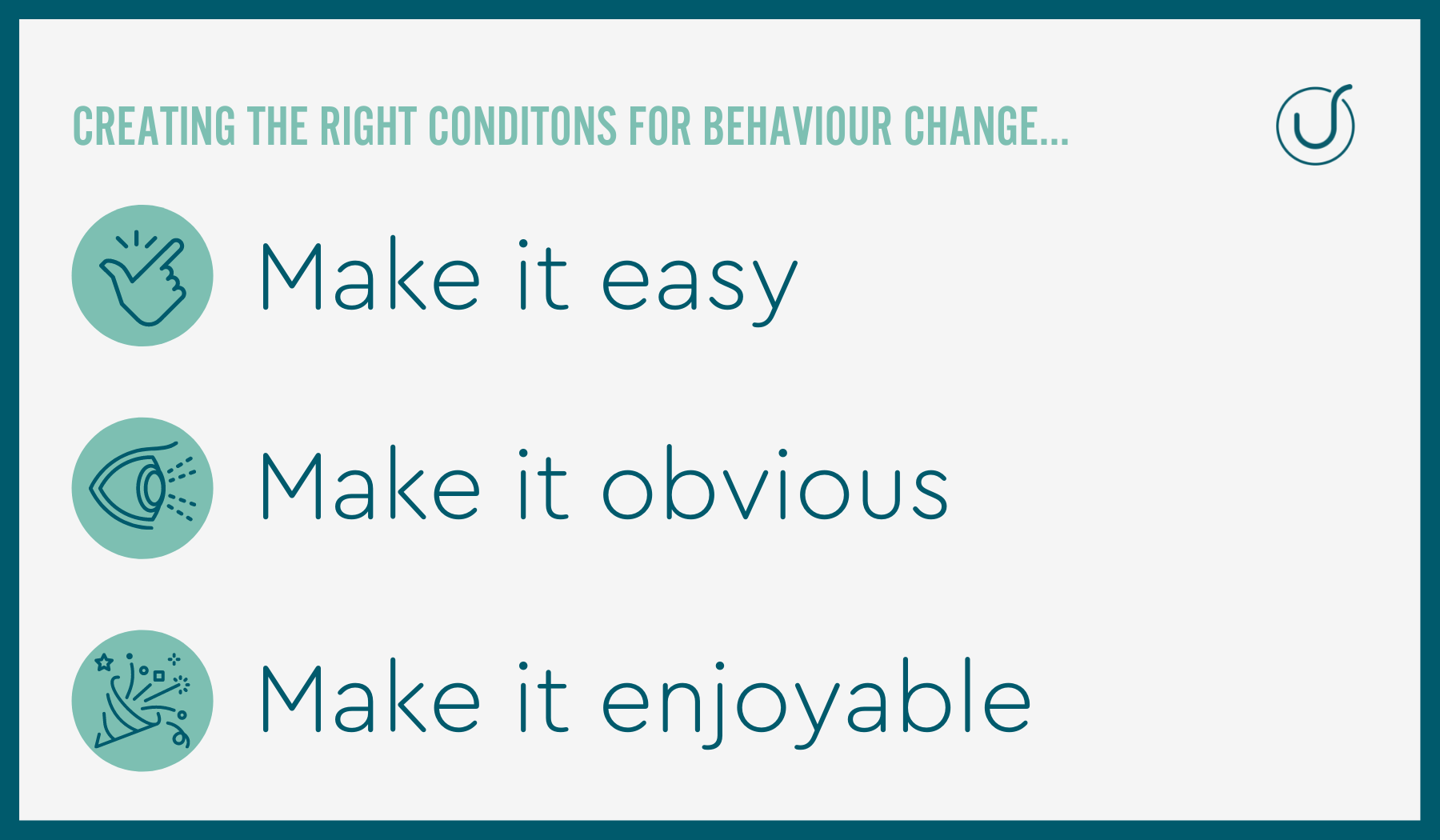
Creating the optimal conditions for behaviour change: make it easy, obvious and enjoyable
By Carolyn Quainton in Behaviour, Consultancy, Customer, Employee engagement, Inspiration
If you want to change your life, start by changing your behaviour. If you want to transform your organisation’s culture, focus on changing your employees’ behaviour.
So how do you create the right conditions for the right behaviours to take root—and stick?
In last month’s blog, we explored why sustainable behaviour change often fails. Two common culprits emerged:
We try to do too much too soon. Long-lasting change starts small. Success comes from breaking big aspirations into bite-sized, manageable steps.
We obsess over goals. Instead of focusing solely on what we want to achieve, we need to ask: who do we want to become? And what systems must we build to support that transformation?
Drawing on the work of best-selling behavioural scientists B.J. Fogg (Tiny Habits) and James Clear (Atomic Habits), we’ve distilled the foundations of behaviour change into three actionable principles. Whether you’re boosting employee engagement or enhancing customer experience, these principles help create the optimal conditions for success.

Make it easy
Easy behaviours win. With just a few clicks, we can order a takeaway or furnish a flat. The easier a behaviour feels, the more likely we are to adopt it.
So, if you want to build new habits, either personally or across your team, reduce the effort required:
Reduce or increase friction. If you want a positive behaviour to stick, remove the barriers. Likewise, if you want to kill off a bad habit, make it harder. Want to watch less TV? Unplug it and hide the remote. Want to cut down on snacks? Keep them out of the house, or at least out of easy reach.
Apply the two-minute rule. Break a new behaviour into small steps that take two minutes or less. Don’t commit to reading a book a week; commit to reading one page a night. Starting is the key to consistency.
Make it obvious
We live in a world full of cues. A green light triggers us to accelerate. A buzz in our pocket prompts us to check our phones. The same logic applies to behaviour change: if we want to embed a habit, we need to design prompts that make it unmissable.
Alter your environment. If you want to practise the guitar, don’t keep it in a cupboard—put it centre stage in your living room. Make the cue as visible and as convenient as possible.
Use action prompts. Tie a new behaviour to something you already do. For instance, if you want to build strength, do 10 squats while waiting for the kettle to boil. Turn routines into springboards.
Make it enjoyable
We naturally repeat behaviours that feel good. So when we build new habits, we should find ways to make them satisfying, even enjoyable.
Link the behaviour to a reward. Good behaviours often take time to show results. You won’t get a six-pack from one gym visit. But by linking habits to instant rewards—like an episode of your favourite show after studying—you’ll build motivation and momentum.
Reframe the experience. Our mindset matters. Instead of saying “I have to”, say “I get to”. Turning obligations into opportunities helps us find joy in the process and reinforces positive behaviour.
How to apply these principles in your organisation
Let’s put theory into practice. Suppose your customer-facing team is struggling with poor satisfaction scores and increasing complaints. You want them to deliver outstanding customer service, warm, friendly, empathetic and helpful. Here’s how to approach that challenge using behavioural insight:
Make it easy. Start small. Ask every employee to smile at every customer they see whether in a shop, hotel or train station. Smiling is a simple, achievable behaviour that lays the foundation for better interactions.
Make it obvious. Use prompts such as mirrors, signs, even role modelling from team managers to encourage smiles. Smiling is contagious, and when people see others do it, they’re more likely to follow suit.
Make it enjoyable. Highlight the benefits of smiling: it boosts mood, reduces stress, diffuses conflict, and makes people appear more attractive and approachable. Help your team feel good about the behaviour, and they’ll be more likely to repeat it.
Let’s help you drive real behaviour change
Most training programmes fail because they focus purely on information, not transformation. Real behaviour change doesn’t just require knowledge, it demands the right strategies, mindset and motivation. That’s where we come in.
At Understood, we use behavioural insight and consultancy expertise to design programmes that deliver measurable behaviour change. Whether you’re aiming to improve employee engagement, enhance customer experience or shift organisational culture, we help you create the conditions where the right behaviours flourish.
Ready to build better behaviours?
Contact us to explore how we can support your organisation in creating long-lasting change.
Talk to us, explore our website, read our blog, and follow us on LinkedIn to learn more and discover ways to grow a more successful business.


